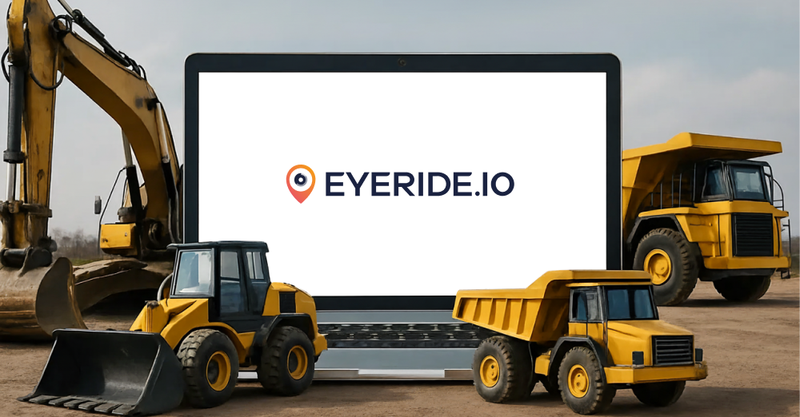
Heavy Equipment Fleet Management Software: 10 Reasons Your Current System Isn't Working (And How to Fix It)
Picture this: It's 6 AM on a Monday, and your most expensive excavator just broke down on the job site. Your crew is standing around, the client's breathing down your neck, and you're frantically digging through spreadsheets trying to figure out when this machine was last serviced. Sound familiar? You're not alone: thousands of fleet managers are drowning in inefficient systems that promise the world but deliver frustration instead.
If your heavy equipment fleet management software feels more like a burden than a solution, you're dealing with problems that cost real money. We're talking emergency repairs that could have been prevented, compliance headaches that invite hefty fines, and operational chaos that kills your bottom line. The good news? Most of these issues have straightforward fixes once you know what to look for.
1. Your System Only Works With One Equipment Brand
Here's a reality check: most construction and industrial operations run mixed fleets. You've got Caterpillar dozers, John Deere excavators, and Komatsu loaders all working the same job site. But your current software? It only talks to one brand, leaving huge blind spots in your fleet visibility.
This fragmentation forces you to juggle multiple dashboards, manually reconcile data, and make decisions based on incomplete information. You're essentially flying blind with 60% of your fleet.
The fix: Choose equipment-agnostic software that integrates with multiple manufacturers through open APIs. Modern platforms can pull data from virtually any machine with telematics capabilities, giving you that single-pane-of-glass view you actually need.

2. You're Bleeding Money on Features You Never Use
Your current system probably came with every bell and whistle imaginable: advanced analytics, predictive modeling, integration with seventeen different third-party apps. The sales pitch was impressive, but six months later, your team uses maybe 30% of what you're paying for.
Those unused features aren't just wasted money; they're adding complexity that slows down adoption and creates confusion among your staff.
The fix: Before selecting new software, clearly define your core pain points. Do you need better work order management? Improved preventive maintenance scheduling? Enhanced compliance tracking? Focus on platforms that excel at your specific needs rather than trying to be everything to everyone.
3. Compliance Gaps Are Creating Regulatory Nightmares
OSHA and DOT compliance isn't optional: it's the difference between smooth operations and catastrophic fines. If your current system can't automatically track inspections, generate compliance reports, or maintain proper audit trails, you're playing regulatory roulette.
Every missed inspection or incomplete documentation creates potential liability that could shut down your operation or cost thousands in penalties.
The fix: Implement software specifically designed with compliance in mind. Look for automated inspection reminders, digital documentation capabilities, and built-in regulatory reporting. Your system should make compliance easier, not harder.
4. Your Software Lives in an Island (And That's Killing Efficiency)
Your fleet management software doesn't talk to your accounting system. Your work orders don't sync with dispatch. Your parts inventory exists in a completely separate universe. This fragmentation forces duplicate data entry, increases errors, and makes simple tasks unnecessarily complex.
When your systems can't communicate, your people waste time on manual workarounds instead of focusing on productive work.
The fix: Prioritize integration capabilities during software selection. Your fleet management platform should seamlessly connect with existing business systems: accounting, payroll, inventory management, and dispatch software. Real integration eliminates data silos and creates operational efficiency.
5. Calendar-Based Maintenance Is Costing You Thousands
"Service every 30 days" might sound systematic, but it's actually wasteful and potentially dangerous. Equipment operating in harsh conditions needs more frequent attention, while machines in lighter duty are being over-maintained at unnecessary intervals.
This one-size-fits-all approach leads to unexpected breakdowns (because you missed early warning signs) and wasted resources (because you're servicing equipment that doesn't need it).
The fix: Switch to usage-based maintenance scheduling that considers actual operating conditions. Modern software analyzes equipment hours, performance metrics, and environmental factors to recommend maintenance only when needed. You'll reduce emergency repairs while optimizing maintenance costs.

Ready to stop the guessing game? Talk to a fleet specialist today — call 833-393-7433 (833-EYERIDE) or visit eyeride.io to request a demo, a quote, or more info via our website or by phone.
6. Your Interface Requires a Computer Science Degree
If your mechanics need three clicks and two dropdown menus just to log a repair, your system is too complex. When field workers find the software frustrating or confusing, they'll revert to pen and paper: which defeats the entire purpose of digitization.
Complex interfaces create adoption resistance and incomplete data entry, making your expensive software investment worthless.
The fix: Choose software with intuitive, mobile-first design. Your field teams should be able to update work orders, log inspections, and access equipment history from their phones in under 30 seconds. If it's not that simple, keep looking.
7. Poor Training Turned Your Team Into Software Skeptics
Even the best software fails without proper implementation and training. Many fleet managers focus on technical setup while neglecting the human element: helping employees understand not just how to use the system, but why it benefits their daily work.
When your team doesn't understand the value proposition, they'll resist adoption and find workarounds that undermine your investment.
The fix: Invest in comprehensive change management alongside software implementation. Clean up existing data before migration, provide hands-on training that explains the "why" behind processes, and offer ongoing support during the transition period.
8. Your ROI Is Negative (And Getting Worse)
If your software costs more than it saves, something's fundamentally wrong. High licensing fees, implementation costs, and ongoing maintenance expenses should be offset by reduced downtime, lower emergency repair costs, and improved operational efficiency.
When fleet management software increases your operational overhead without delivering measurable savings, it's become part of the problem instead of the solution.
The fix: Focus on platforms that drive concrete cost reductions: decreased equipment downtime, reduced emergency repairs, optimized parts inventory, and extended asset lifespans. Calculate ROI based on operational improvements, not just software features.

9. Reactive Maintenance Is Bleeding Your Budget Dry
The "fix it when it breaks" approach might seem cost-effective upfront, but it's financial suicide longterm. Emergency repairs cost three to five times more than scheduled maintenance, and unexpected downtime can derail entire projects.
One construction company ignoring preventive maintenance for two years faced nearly $180,000 in emergency repairs and lost business opportunities. That's preventable with the right system and approach.
The fix: Implement predictive maintenance capabilities that identify issues before they become failures. Your software should analyze equipment patterns, generate automated work orders for preventive tasks, and alert you to developing problems based on performance data.
10. Your System Can't Scale With Business Growth
Software that works perfectly for 10 pieces of equipment often collapses under the complexity of 50+ machines. Poor scalability means you'll face the same selection and implementation process again as your business grows: multiplying costs and disruption.
Similarly, inadequate data migration from legacy systems can create garbage data that undermines decision-making for years.
The fix: Select platforms built for scalability from day one. Look for unlimited user capabilities, robust data migration tools, and architecture that handles increasing complexity without performance degradation. Your software should grow with your business, not constrain it.
The Path Forward: Making Fleet Management Work for You
Your current fleet management system isn't working because it addresses symptoms rather than root causes, operates in isolation from your broader business needs, or overwhelms your team with unnecessary complexity.
The most effective solutions combine intelligent maintenance scheduling, seamless business system integration, intuitive user design, and proven scalability. When you can predict maintenance needs instead of reacting to failures, integrate fleet data with business operations, and empower your team with simple yet powerful tools, everything else falls into place.
Don't settle for software that creates more problems than it solves. Your heavy equipment represents enormous capital investment: it deserves management technology that actually works. The right fleet management platform transforms operational chaos into predictable efficiency, turning your biggest operational headache into a competitive advantage.
Ready to move? Call 833-393-7433 (833-EYERIDE) or visit eyeride.io to request a demo, a customized quote, or more info via our website or by phone. Our team will walk you through EYERIDE FMS and show you exactly how to centralize operations, boost safety with AI, and get real-time visibility across every asset.